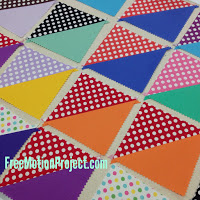Machine Quilting Over Intense Patchwork
Click Here to subscribe to our YouTube Channel so you don’t miss out on any new videos!
The quilt top in the video was the Hokey Pokey Crazy Quilt which was my most heavily pieced quilt on hand. Here’s how I’ve made this quilt easier to finish starting with the piecing:

#1 – Piece quilts with a short stitch length – If you’re at all worried about your pieces not holding together securely, lower your stitch length! I piece with a 1.5mm stitch length so the pieces are firmly locked together and a total pain to pick out. This allows me the freedom to…
#2 – Press seams open – When piecing I have my pressing board set up next to the machine so I can stitch a seam, finger press it open, then give it a firm press with my iron. It doesn’t take any more time and it results in super flat seams.
#3 – Little or no ditching – All those seams will be even more tricky to deal with if you have to stitch them ALL in the ditch. The more pieces and seams in a quilt, the less likely I am to ditch because it will be time consuming and tedious. I might ditch around a block, but not the individual pieces within the block. It really just depends on the quilt style and design and how much time I’m willing to invest in it.

#4 – Avoid Intense Areas – Spread out your quilt top and feel the surface. Anywhere you feel a noticeable hard lump, draw a circle around it with a fabric marking pencil. Now when you go to machine quilt, aim to avoid those areas of intensity by stitching around them.
Instead of whacking directly against a lumpy spot and getting your foot caught up and your needle potentially broken, just avoid that area and keep on stitching.
Yes, for many intensely pieced quilts, the best way to quilt them quickly is All-Over style which will give you the freedom to avoid quite a lot of spots like that.
What do you think? Are you willing to take the extra time to press seams open or is this a technique that gives you chills? Do you think it’s a waste to use an All-Over design on an intensely pieced quilt top? Share your opinions in the comments below!
Let’s go quilt,
Leah Day

Hi Leah,
I am getting ready to quilt a signature/comfort quilt for my friend and should I not quilt the signature blocks?
thanks
I too prefer all over quilting on a busy top. I tend to press my seams open as well except if the seams can nest –occurs more with squares than angled seams. The nesting helps using less pins. But with nesting you also have to pay more attention to which way to nest.
I would leave the signature areas open so there is space to sign. You could even emphasize those areas by ditching around those particular spaces. Sometimes it's worth putting a bit more effort into a project, even if you have to hit hard seams directly, if it's really special to you.
I have never stitched an all over design on a quilt. When I'm quilting I like to quilt in a way that makes some sections jump out and others not and I feel that all over quilting can take away from the look of some quilts. Just my personal preference. I don't ditch stitch every seam either, I grid out the quilt when I first start, working out from the centre and then just wing it from there!
Yay for pressing seams open and using a shorter stitch length!
Great thanks Leah – will do.
Sue
Great info…thanks for sharing.
Great ideas….I'll be trying those methods in my next few quilting projects…and they are piling up…lol. Leah…your are so inspirational…thanks.
Following your advice to press seams open…made Free motion quilting at least 25% EASIER…it was a huge relief on my shoulders too! I noticed how much easier it was in the first 5 minutes of quilting. Thank you SEW much.
Would you also recommend to press seams open when the blocks are hand pieced.
The flannel I mentioned would be on the back.
I have just discovered your website-fantastic! I am about to begin quilting a hexagon I spy quilt and I wondered about using your matrix pattern? Also do you have comments about using well washed flannel?
Great question! You can definitely use Matrix to quilt as an All-over design. You'll want to start in the center of the quilt with a wiggly line, then rotate the quilt around and stitch a wiggly line in the opposite direction. It's a lot more shifting and movement than a design like Sharp Stippling, but it still produces an open, beautiful design.
So long as the flannel is well washed, this should be no problem. Definitely use a queen supreme slider as the flannel fabric will tend to grip your table and make it seem harder to move.
Nope. For hand piecing, it generally is better to press seams to one side rather than open. The reason is your stitches are just not going to be as small or consistent than they will by machine.
Awesome! I love knowing this has helped you quilt your quilts easier!
Thank you! I was just puzzling yesterday over a quilt top with busy fabric (not exactly the same, but similar…), and not wanting the quilting to fight the fabric. All over quilting might be the answer!
Thanks to Melody Lutz for sharing her experience. Don't have a top with open seams ready for quilting yet. I've just recently started pressing my seams open, though I never remember to decrease the stitch length.